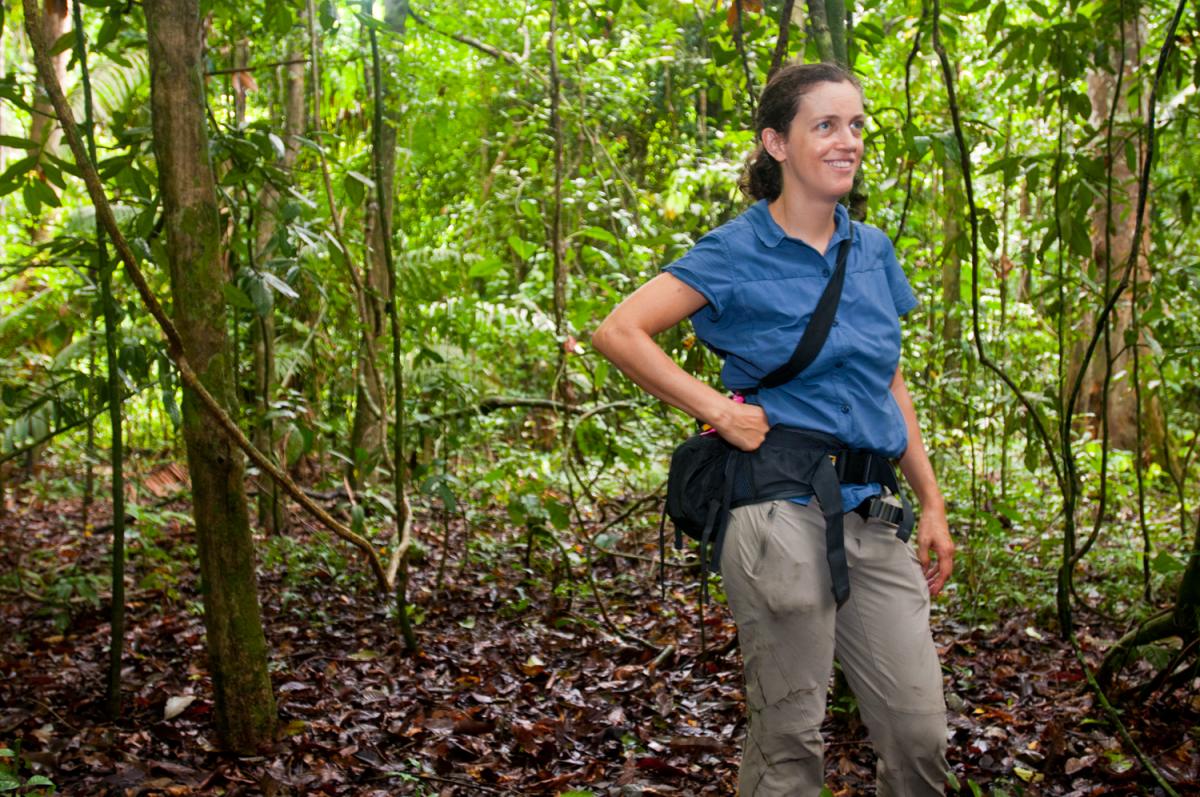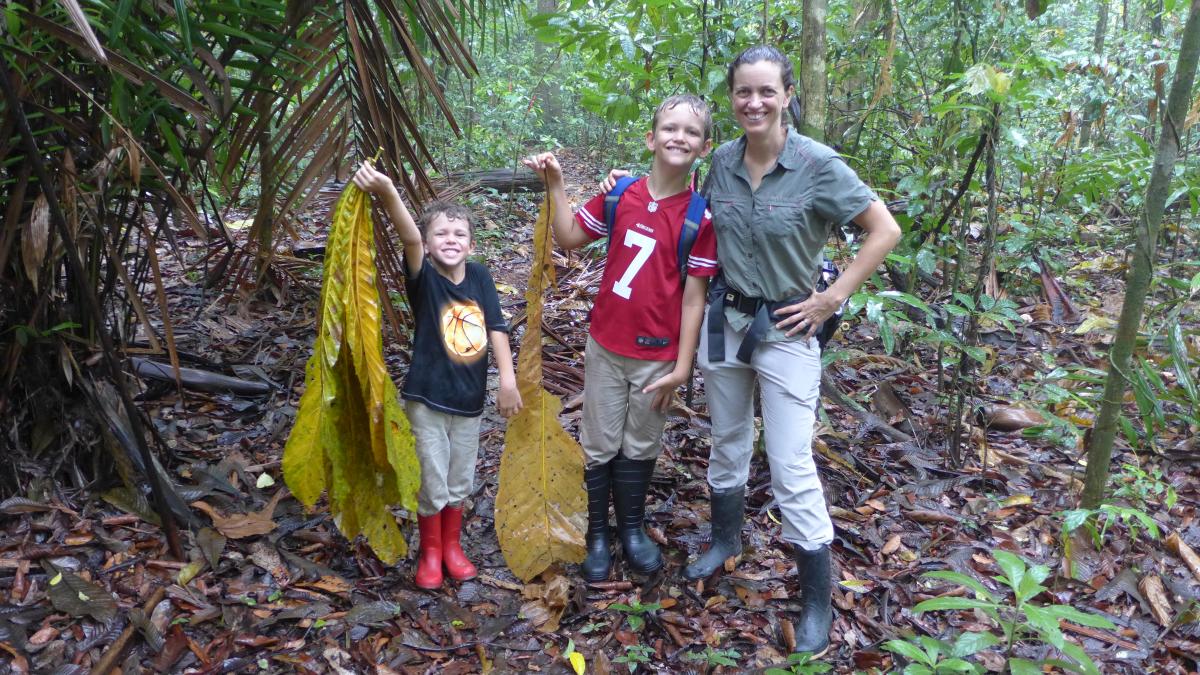Helene Muller-Landau Receives Secretary’s Research Prize
Helene Muller-Landau is a senior staff scientist with the Smithsonian Tropical Research Institute, and she leads ForestGEO’s Global Carbon Program. On December 9, 2021 Helene received the Secretary’s Research Prize, a Smithsonian award in recognition of excellence in research.

You’ve been awarded the Secretary’s Research Prize for your chapter “What Determines the Abundance of Lianas and Vines?” in Unsolved Problems in Ecology. Why are lianas and vines important to understand?
Climbing plants—a group that includes both lianas (woody) and vines (nonwoody)—are found in a majority of the world’s forests, at widely varying abundances. The abundance of climbers is critically important to determining forest carbon stores and cycling. Where there are more lianas and vines, trees grow more slowly, forests store less carbon, and forest structure is altered, with implications for the diversity and abundance of other plants and animals within the forest. Further, the effects of lianas differ among tree species, and thus the relative performance of tree species depends on liana abundance.
Did ForestGEO research inform this chapter, and if so, how?
My interest in the topic of lianas was stimulated in large part by observations, data, and findings on lianas in the ForestGEO plot on Barro Colorado Island, Panama. Previous studies in the plot, most led by STRI Research Associate Stefan Schnitzer, quantified the abundance and distribution of lianas, their role in gap dynamics in the plot, and their negative effects on individual tree reproduction, growth, and survival. And considering how lianas could slow forest regeneration in gaps, reduce tree growth, and increase tree mortality, it was clear they strongly affected forest carbon stocks and fluxes, something I think about a lot as lead scientist of the ForestGEO Carbon Program.

You co-authored this chapter with Stephen W. Pacala. How did you decide to collaborate on this project?
It all started with conversations in fall 2015, when I was on sabbatical at Princeton University, where Steve Pacala is a professor. Steve posed the question of why lianas and vines weren’t a lot more abundant, considering that they avoided the large costs of load-bearing trunks, and thus would seem to have a great competitive advantage. What was limiting them? He initially proposed that lianas might essentially hold themselves back from doing too much damage to host trees, considering that the death of the host tree would remove the liana from its favorable position in the canopy. I countered that many tropical trees with lianas have not only multiple individual lianas but multiple liana species in their crowns, which could lead to a tragedy of the commons in which the best strategy for each individual liana is to try to exploit the host as completely as possible, even if that killed the host. I suggested that infestation dynamics likely were most important – that is, whatever factors controlled liana colonization rates and loss rates from host trees. We debated these and many other ideas, and realized that despite a lot of research on lianas, the controls on liana abundance were really unknown. And yet at the same time, we saw a path forward for figuring them out, based on the conceptual models we developed. Right about then, another Princeton professor, Andy Dobson, invited me to contribute a chapter to this edited book on unsolved problems in ecology, and I decided this topic would be perfect!
The Secretary’s Prize comes with $2,000 in research funds. What might those funds facilitate in your research program?
I’m planning to use the funds to contribute to stipend for an intern to participate in more research on lianas. This paper lays out a number of research questions and hypotheses that I’m eager to address with new empirical data collection and analyses on lianas in Panama. I’d be happy to hear from interested students!

Remarks from Ross Irwin at the ceremony for the Secretary's Research Prize:
"One reviewer wrote glowingly of the chapter’s originality: 'I have not seen anything remotely similar. The idea to adapt concepts from disease-ecology is extremely innovative... After reading this article, I have many ideas for possible research directions, ranging from field experiments to new theory and models. For me, the ultimate test of useful research is whether it leaves you full of ideas. This paper certainly does.' A second reviewer explained, 'by providing a general quantitative theory, Muller-Landau’s chapter paves the way for incorporating lianas into general vegetation models, which inform trajectories and thereby policy for national and global CO2 emissions.' The chapter has already inspired follow-up papers in top journals and promises to become a foundational guide for research in vines and forest ecology for decades to come."
Remarks from Helene Muller-Landau at the ceremony for the Secretary’s Research Prize:
“Thank you – I’m really honored.
First and foremost, I’d like to thank my coauthor Steve Pacala. We developed these ideas and wrote this manuscript together during my sabbatical in his lab at Princeton University a few years ago. I thank the administration of the Smithsonian Tropical Research Institute for making that sabbatical possible, and I thank the Department of Ecology and Evolutionary Biology at Princeton for hosting me.
This work benefited from many stimulating conversations with and thoughtful comments by multiple colleagues at the Smithsonian, Princeton, and elsewhere, including Rae Winfree, Joe Wright, Simon Levin, and the late Henry Horn.
The development of these ideas grew in part from observations, data, and findings on lianas made at the Smithsonian’s research station at Barro Colorado Island, Panama. I thank the other scientists, technicians, and students who have contributed to those observations and datasets, and the support staff that makes it possible for all of us to do research in the forest there.”
